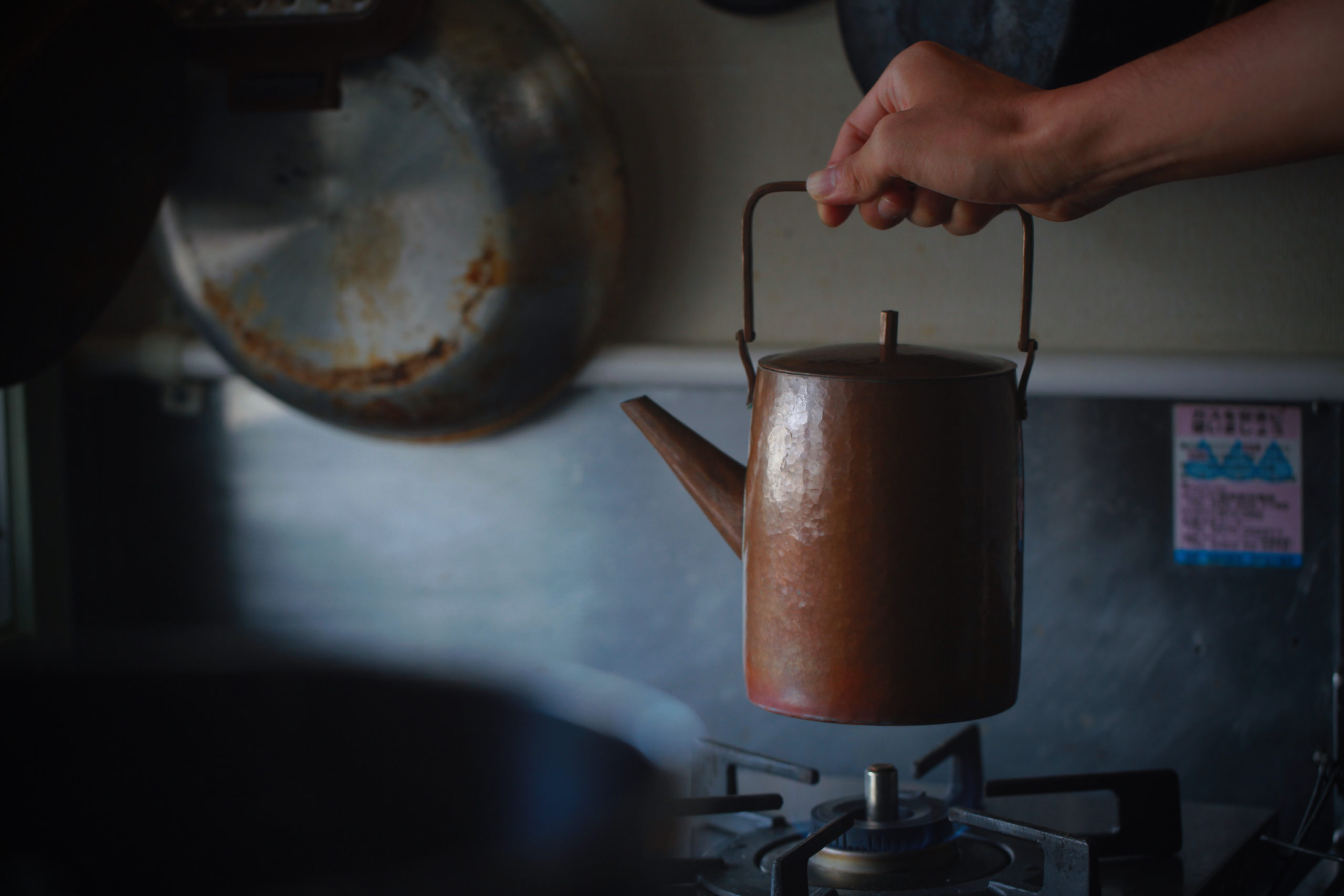冬のとびきり寒く布団から出たくない朝も、夏の起きると暑くてたまらない朝も先ず一番にやることはこの薬缶を手で一通り愛でてお湯を沸かすことだ。季節の少しの変化も薬缶が教えてくれる。少し寒くなりだした冬のはじめいつもより少し沸点に到達するまでの時間が長くなる。準備ができたときの音も「シンシン」と奏でる音程が夏のそれとは異なるから面白い。「シンシン」と奏でる音がまだ誰も起きていないキッチンで鳴っている。この自分だけの時間は格別だ。そんなBGMと共に珈琲を淹れる準備をはじめる。冷蔵庫から保管しているネルを取り出して水を絞る。そして乾いたタオルに包んでパンパンと叩いて水気を取る。ここまできたら弱火にしておいた薬缶の火を消す。こうしておくことでドリップポットに注ぐ時にお湯が暴れなくなる。豆を珈琲缶から取り出し様子を見て手挽きグラインダーでごりごりと挽く。この時立ち込める香りがまた堪らない。挽き終えた段階で落ち着いた薬缶からポットへお湯をうつす。火で沸かしたお湯は電気で沸かしたお湯よりとろとろしている感覚がある。自身が使用している薬缶は奈良で金工をされている中村友美さんのもの。彼女の創りだす形はものそれだけに留まらずその周りの空間、背景までが一つの作品として成り立っていると感じる。奈良の工房兼ご自宅へお邪魔させて頂き彼女の一番最初につくった薬缶をみせて頂いたことがあるがその佇まいは初期の頃から他には類を見ない特別な存在感を放っていた。この薬缶の魅力は育てるということにもあると思う。各々の日常の文脈の違いによってこの銅の景色がどんな風に経年変化していくか、それはこの薬缶と生活を積み重ねていく上でとても愉しみなことだ。この薬缶が奏でる音と共に珈琲があることがこの上なく嬉しい。
Whether it’s a very cold winter morning when I don’t want to get out of the futon, or a very hot summer morning when I wake up, the first thing I do is to love this medicine can with my hands and boil water. The can also tells me the slight changes in the seasons. In the beginning of winter, when it starts to get a little cold, it takes a little longer than usual to reach the boiling point. The sound it makes when it’s ready is also interesting, because the pitch of its “sing-sing” is different from that of summer. It’s interesting because the pitch of the “sing-sing” sound when it’s ready is different from that of summer, when no one is awake in the kitchen. This is a very special time for me. With such background music, I start preparing to make a cup of coffee. I take out the flannel from the refrigerator and squeeze out the water. Then I wrapped it in a dry towel and patted it to remove the water. When you have finished, turn off the flame of the canister that you have set on low heat. This will prevent the hot water from getting out of control when you pour it into the drip pot. Remove the beans from the coffee can and grind them with a hand grinder. The aroma that comes from the grinder is irresistible. When I finished grinding, I poured the hot water from the can into the pot. The water boiled by the fire feels thicker than the water boiled by electricity. The cans she uses are made by Ms. Tomomi Nakamura, a metalworker in Nara. I feel that the shapes she creates are not only limited to the object itself, but also the space and background around it as a single work of art. I once visited her at her studio and home in Nara to see the first medicine cans she made, and their appearance had a special presence that was unparalleled since the early days. I think the appeal of these cans lies in the fact that they can be nurtured. The way the copper landscape changes over time depending on the context of each person’s daily life is what makes living with this medicine can so enjoyable. I am very happy to have coffee with the sound that this can makes.
